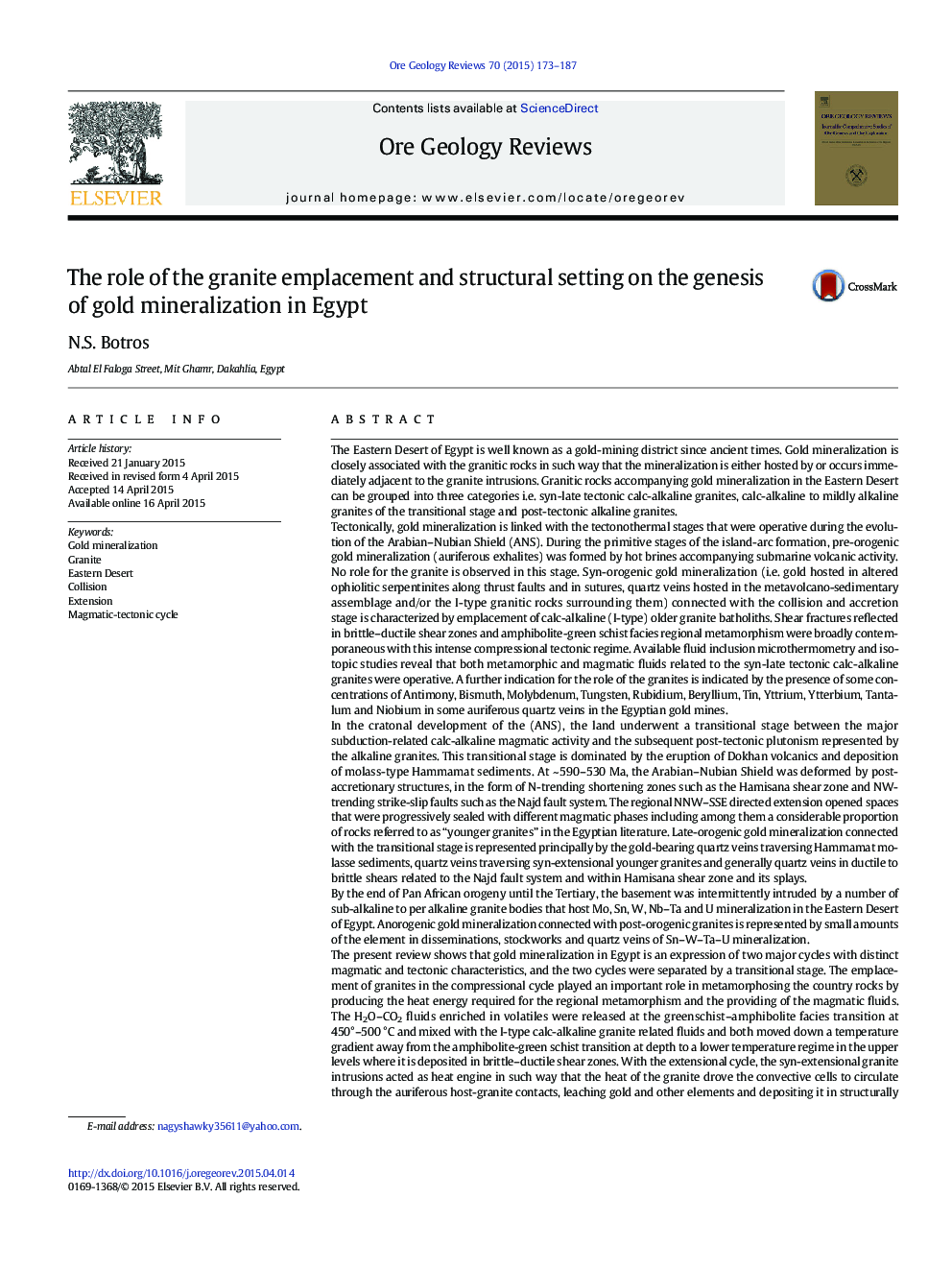| کد مقاله | کد نشریه | سال انتشار | مقاله انگلیسی | نسخه تمام متن |
|---|---|---|---|---|
| 4696974 | 1637234 | 2015 | 15 صفحه PDF | دانلود رایگان |
The Eastern Desert of Egypt is well known as a gold-mining district since ancient times. Gold mineralization is closely associated with the granitic rocks in such way that the mineralization is either hosted by or occurs immediately adjacent to the granite intrusions. Granitic rocks accompanying gold mineralization in the Eastern Desert can be grouped into three categories i.e. syn-late tectonic calc-alkaline granites, calc-alkaline to mildly alkaline granites of the transitional stage and post-tectonic alkaline granites.Tectonically, gold mineralization is linked with the tectonothermal stages that were operative during the evolution of the Arabian–Nubian Shield (ANS). During the primitive stages of the island-arc formation, pre-orogenic gold mineralization (auriferous exhalites) was formed by hot brines accompanying submarine volcanic activity. No role for the granite is observed in this stage. Syn-orogenic gold mineralization (i.e. gold hosted in altered ophiolitic serpentinites along thrust faults and in sutures, quartz veins hosted in the metavolcano-sedimentary assemblage and/or the I-type granitic rocks surrounding them) connected with the collision and accretion stage is characterized by emplacement of calc-alkaline (I-type) older granite batholiths. Shear fractures reflected in brittle–ductile shear zones and amphibolite-green schist facies regional metamorphism were broadly contemporaneous with this intense compressional tectonic regime. Available fluid inclusion microthermometry and isotopic studies reveal that both metamorphic and magmatic fluids related to the syn-late tectonic calc-alkaline granites were operative. A further indication for the role of the granites is indicated by the presence of some concentrations of Antimony, Bismuth, Molybdenum, Tungsten, Rubidium, Beryllium, Tin, Yttrium, Ytterbium, Tantalum and Niobium in some auriferous quartz veins in the Egyptian gold mines.In the cratonal development of the (ANS), the land underwent a transitional stage between the major subduction-related calc-alkaline magmatic activity and the subsequent post-tectonic plutonism represented by the alkaline granites. This transitional stage is dominated by the eruption of Dokhan volcanics and deposition of molass-type Hammamat sediments. At ~ 590–530 Ma, the Arabian–Nubian Shield was deformed by post-accretionary structures, in the form of N-trending shortening zones such as the Hamisana shear zone and NW-trending strike-slip faults such as the Najd fault system. The regional NNW–SSE directed extension opened spaces that were progressively sealed with different magmatic phases including among them a considerable proportion of rocks referred to as “younger granites” in the Egyptian literature. Late-orogenic gold mineralization connected with the transitional stage is represented principally by the gold-bearing quartz veins traversing Hammamat molasse sediments, quartz veins traversing syn-extensional younger granites and generally quartz veins in ductile to brittle shears related to the Najd fault system and within Hamisana shear zone and its splays.By the end of Pan African orogeny until the Tertiary, the basement was intermittently intruded by a number of sub-alkaline to per alkaline granite bodies that host Mo, Sn, W, Nb–Ta and U mineralization in the Eastern Desert of Egypt. Anorogenic gold mineralization connected with post-orogenic granites is represented by small amounts of the element in disseminations, stockworks and quartz veins of Sn–W–Ta–U mineralization.The present review shows that gold mineralization in Egypt is an expression of two major cycles with distinct magmatic and tectonic characteristics, and the two cycles were separated by a transitional stage. The emplacement of granites in the compressional cycle played an important role in metamorphosing the country rocks by producing the heat energy required for the regional metamorphism and the providing of the magmatic fluids. The H2O–CO2 fluids enriched in volatiles were released at the greenschist–amphibolite facies transition at 450°–500 °C and mixed with the I-type calc-alkaline granite related fluids and both moved down a temperature gradient away from the amphibolite-green schist transition at depth to a lower temperature regime in the upper levels where it is deposited in brittle–ductile shear zones. With the extensional cycle, the syn-extensional granite intrusions acted as heat engine in such way that the heat of the granite drove the convective cells to circulate through the auriferous host-granite contacts, leaching gold and other elements and depositing it in structurally favorable sites. In addition, the contrasts in competency between the granites with brittle deformational characteristics and the surrounding country rocks with a ductile response to stress, led to a generation of extensive fracture pattern within the more competent unit.
Journal: Ore Geology Reviews - Volume 70, October 2015, Pages 173–187
